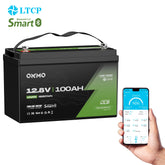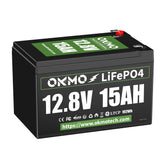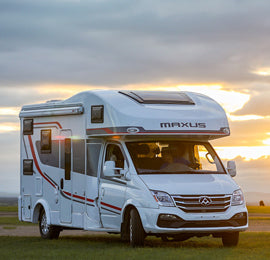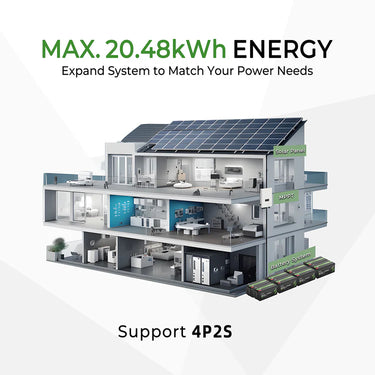What Are Group 31 Deep Cycle Batteries?

Group 31 is a standardized battery size classification (defined by BCI), and a deep cycle battery is designed for prolonged, stable discharge. Combined, a Group 31 Deep Cycle Battery refers to a deep cycle battery that adheres to the Group 31 size specifications. Its key features include high capacity and long cycle life, making it ideal for applications requiring repeated charging and discharging.
-
Core Design Features:
-
Thick Plates: Unlike standard starter batteries (thin plates), deep cycle batteries use thicker lead plates to withstand deep discharges (80-100% DOD) without damage.
-
High Capacity: Typical capacities range from 90-125Ah (lead-acid) to 200Ah (lithium variants).
-
Long Cycle Life: Lead-acid versions last 500-800 cycles, while lithium (LiFePO4) models can endure 4,000-15,000 cycles.
-
2. Group 31 Deep Cycle Batteries vs. Other Batteries
| Criteria | Group 31 Deep Cycle Battery | Standard Automotive Starter Battery | Other Deep Cycle Batteries (e.g., Group 27) |
|---|---|---|---|
| Primary Use | Long-term discharge (storage, power supply) | Short-term high-current bursts (engine starting) | Medium-capacity storage (small RVs, fishing boats) |
| Depth of Discharge (DOD) | 80-100% | 20% (deep discharges damage the battery) | 50-80% |
| Plate Design | Thick plates, corrosion-resistant | Thin plates for high surface area | Medium-thickness plates |
| Typical Capacity | 90-125Ah (lead-acid) / 100-200Ah (lithium) | 50-70Ah | 70-90Ah |
| Cycle Life | Lead-acid: 500-800 / Lithium: 3,000+ cycles | 200-300 shallow cycles | Lead-acid: 400-600 cycles |
Key Differences:
-
Discharge Capability: Group 31 deep cycle batteries provide steady power for hours (e.g., powering RVs), while starter batteries deliver short bursts of high current (e.g., engine cranking).
-
Durability: Thick plates and deep cycle technology ensure longer lifespan.
-
Applications: Ideal for systems requiring frequent cycling (e.g., solar storage), not one-time high-power needs.

3. Types of Group 31 Deep Cycle Batteries
Based on technology, Group 31 deep cycle batteries are categorized as follows:
-
Flooded Lead-Acid Batteries
-
Pros: Lowest cost (~200−300).
-
Cons: Require maintenance (water refilling), prone to leakage, unsuitable for enclosed spaces.
-
Use Cases: Budget-friendly fixed storage (e.g., rural solar setups).
-
-
AGM Batteries (Absorbent Glass Mat)
-
Pros: Maintenance-free, leak-proof, vibration-resistant, supports 80% DOD.
-
Cons: Higher cost (~300−600), reduced performance in high heat.
-
Use Cases: RVs, marine applications, off-road vehicles.
-
-
Lithium-Ion Batteries (LiFePO4)
-
Pros: Ultra-long lifespan (10+ years), lightweight (60% lighter than lead-acid), 100% DOD, 99% charge efficiency.
-
Cons: High upfront cost (~800−1,500), requires a battery management system (BMS).
-
Use Cases: High-end off-grid solar systems, electric boats, long-term RV travel.
-
-
Gel Cell Batteries
-
Pros: Heat-resistant, leak-proof, ideal for fixed installations.
-
Cons: Sensitive to overcharging, requires precise voltage control.
-
Use Cases: Telecom towers, solar streetlights.
-
4. Primary Applications
Group 31 deep cycle batteries are widely used in:
-
Off-Grid Solar/Wind Energy Storage
-
Stores renewable energy for nighttime use.
-
Recommended Types: Lithium (efficiency) or AGM (cost-effective).
-
-
RVs and Campers
-
Powers lighting, refrigerators, air conditioners, and inverters.
-
Key Needs: High capacity (100Ah+), vibration resistance (AGM or lithium).
-
-
Marine Applications
-
Powers trolling motors, fish finders, and onboard refrigerators.
-
Special Requirements: Waterproofing and corrosion resistance (AGM preferred).
-
-
Golf Carts & Electric Forklifts
-
Drives motors continuously; lithium batteries excel in high-usage scenarios.
-
-
Backup Power Systems
-
Provides emergency power for medical devices, telecom towers, or home lighting.
-

5. How to Choose a Group 31 Deep Cycle Battery?
-
Select by Technology:
-
Budget-friendly: Flooded lead-acid (with maintenance).
-
Durability/convenience: AGM.
-
Long-term investment: Lithium (LiFePO4).
-
-
Key Parameters:
-
Capacity (Ah): Calculate total power consumption (e.g., 100Ah battery ≈ 10 hours for a 100W device).
-
Cycle Life: Lithium may offer lower long-term costs (3,000 cycles vs. 500 for lead-acid).
-
Environment: Gel for heat, AGM for humidity, lithium for cold climates.
-
-
Brand Recommendations:
-
Lead-acid/AGM: Optima, Renogy, VMAXTANKS.
-
Lithium: Battle Born, EcoFlow, Victron Energy.
-
6. Usage & Maintenance Tips
-
Charging:
-
Avoid discharging lead-acid below 50% DOD.
-
Lithium can discharge to 0% but keep 10-20% for longevity.
-
-
Temperature:
-
Lead-acid loses 30-50% capacity in cold; lithium (LiFePO4) performs better.
-
-
Installation:
-
Ensure ventilation (flooded batteries emit hydrogen) and secure mounting (marine/off-road use).
-
 Summary
Summary
Group 31 deep cycle batteries are the gold standard for high-capacity energy storage, excelling in applications requiring deep discharges and frequent cycling (e.g., off-grid power, RVs, marine). Compared to starter batteries, they offer superior lifespan, discharge depth, and stability. Against smaller deep cycle batteries (e.g., Group 27), Group 31 provides greater capacity and energy reserves. Choose based on budget, technology (lead-acid/AGM/lithium), and specific use-case requirements.








